13 Most Surprising Facts About Old Marvel Comics
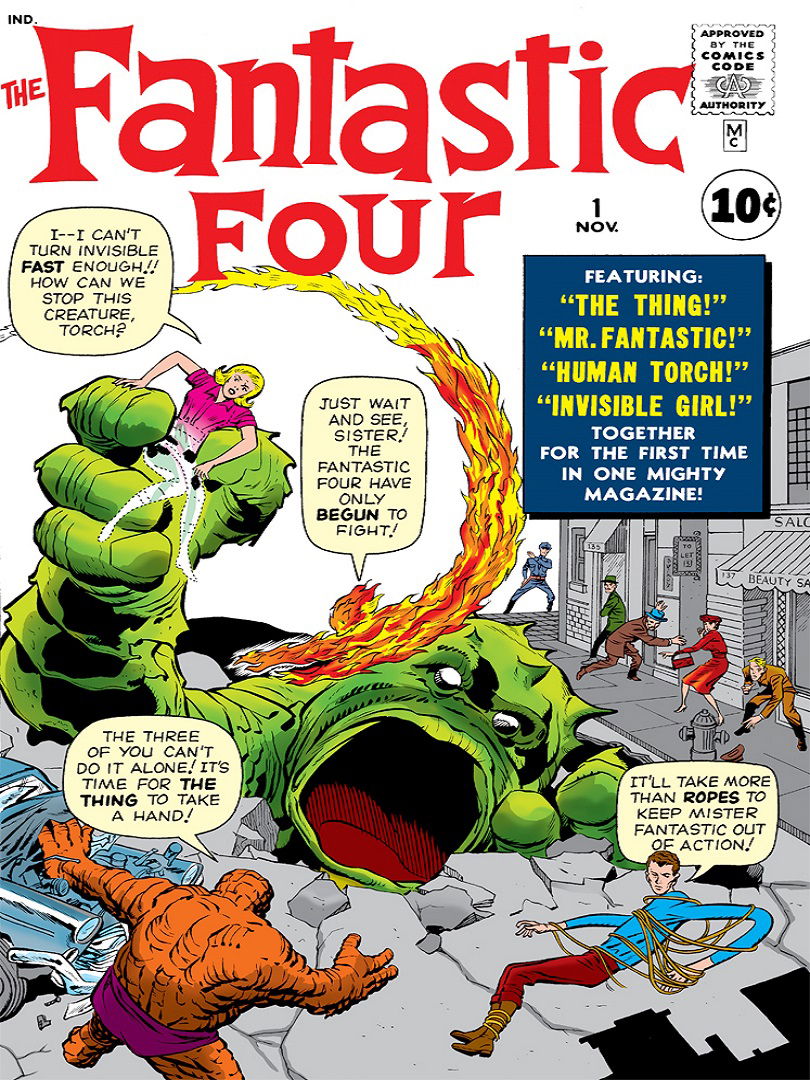
Almost right after I figured out how to read, I started reading comics, losing myself in these magical worlds, and having a blast with whatever I could get my hands on. Unfortunately most of these comics have been Spider-Man comics, and barring the X-Men, all other characters and heroes I have been exposed to have been through their guest appearences in his comics.
As I grew older, I stopped reading comics. Not because they became boring or anything, I have just found new hobbies I got more interested in. Of course, then the MCU's golden era happened, and I got hooked back in this fantasy world, this time realizing how fun it could be to read more about the different heroes, how they tie in together, and explore the Marvel world itself rather than only the characters I was familiar with.
I accomplished this by using the Complete Marvel Reading Order featured in the awesome CMRO website, which is a daunting and kind of a crazy task. I wanted to learn more about this marvellous world, so began to read all those characters I have previously found boring (due to prejudice, looking back at it) like Thor, Captain America, and Hulk among others.
As you expect, what I've found was really surprising. I was prepared to see some of these as I had an idea of what I would find watching the MCU movies, and a good number of the Marvel shows. Some of them were still really unexpected. Here are the most surprising discoveries I have made reading old Marvel comics, starting right from the first issue of Fantastic Four in 1961.
1) Captain America wasn't American propoganda
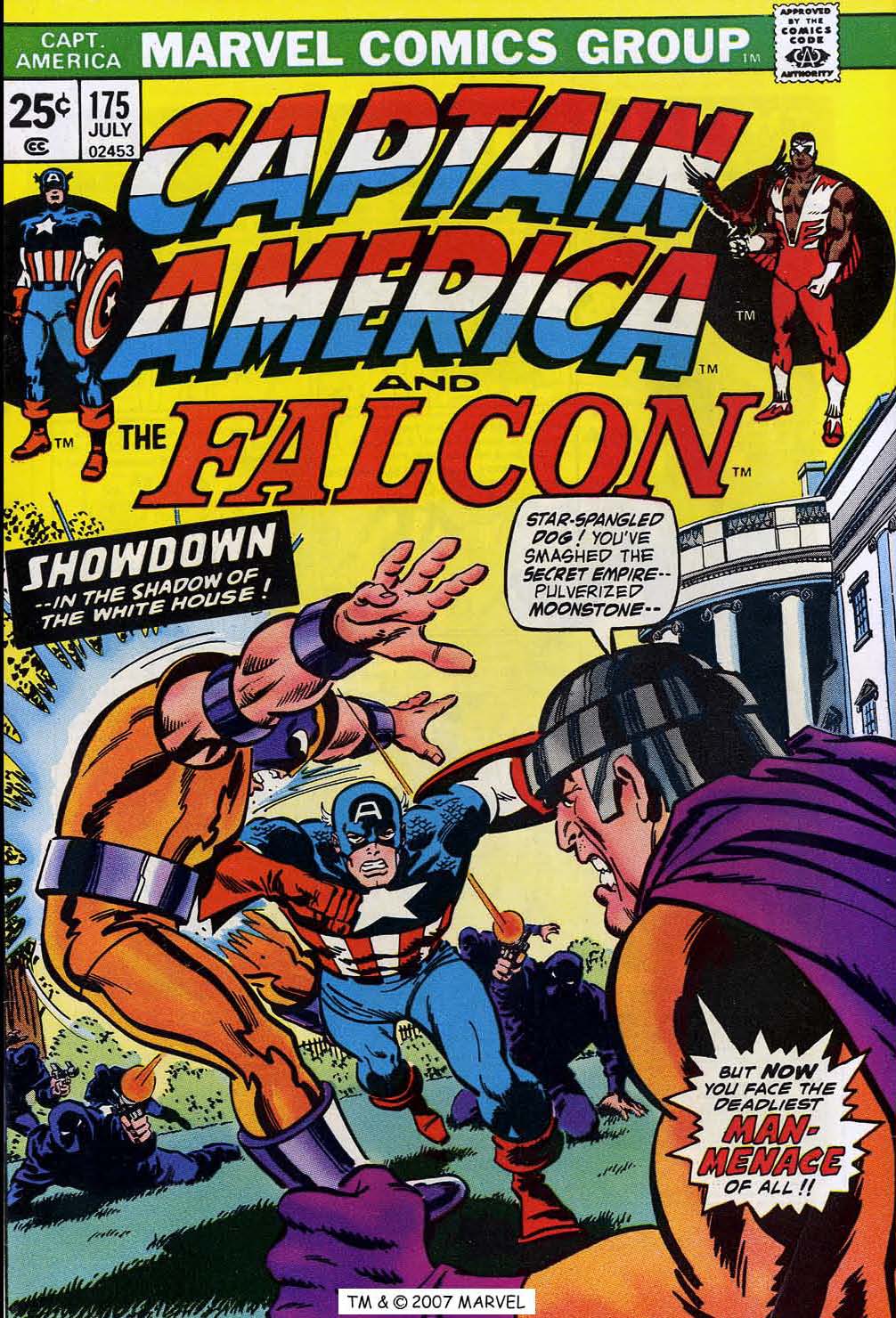
This may be a D'uh moment for people who reads Captain America comics. But being a non-American, whenever I saw or thought about this red-white-and-blue hero, I thought about blatant American propoganda. I mean can you blame me, the dude's name includes America, his uniform reflects the flag of USA, he is supposed to be the wisest hero who is always right, how could I have thought otherwise?
Captain America was most likely a propoganda character at his birth. Indeed in his early comics he consistently praises America, the American army, the American way of life etc., and just wants to serve his country. But a few years after he is reintroduced to modern Marvel comics in Avengers # 4, things begin to change.
Captain America begins to notice how different the political environment of post WW2 era is. He begins to see sometimes the rebels are right, the system is never perfect, and sometimes the bad guys are right in the government itself.
"Back then it was simple," he says. "Nazis were the obvious bad guys, and we were the obvious good guys. There was a clear distinction between good and evil. But nowadays it is a lot more difficult to tell which is which." Almost as if the writers themselves were realizing how true this is, and how tough of a job it is to make the symbol of a nation work as a universal super-hero.
He begins to question himself. He begins to lose faith in his government. These culminate in two critical, very intricately written Captain America stories. In the first of these two stories (Captain America # 153 - 156), a new Captain America, and Bucky attack our Captain America, wanting to take over his position.
These turn out to be the actual Captain America and Bucky characters written in the 50's, and the writer (Steve Englehart) cleverly explains how the issues that were printed in those times could have occured when the real Cap (that was written in the 40's) was supposed to be buried in the ice. These two have been huge fans of Cap and Bucky you see. They also value their country, and what it represents, but they take it too far. Technically it is explained they lose their sanity due to super-soldier serum messing with their minds because they didn't receive Vita-rays unlike the real Cap, but there are obvious intentional symbolisms here.
They turn out blatantly racist. They see anyone not thinking like them as the ultimate evil. They perceive attacks to their way of life in anything they don't understand or approve of. When Captain America defeats them, he sees how he had a very real risk of turning out exactly like them. Indeed, these two villains represent the dangers of idealism and self-righteousness taken too far. That without inherent goodness and common sense that is deeper than the national identity, or your politics, you are in extreme risk of becoming the very evil you fight against. These insights are very obvious in our times, but I can't help but praise them in comics of such age.
The breaking point of his insights occur in Captain America # 169 - 175, when some shady, secret powers begin to advertise against Captain America, then frame him for a murder. Cap and Falcon go criminal mode to uncover what this organization really is. After some adventures that are written surprisingly well, the two find out that the secret evil group is the Secret Empire, and their leader is Richard Nixon himself , the President of the United States at the time the comics was written, although neither his face is shown, nor is his name stated. In a shocking ending, Nixon even commits suicide in front of Cap right inside his White House office.
Captain America is so horrified by his experiences, he refuses to be a symbol of his country. After a brief hiatus he returns to the superhero scene in a new costume with a new name, Nomad, tossing the name America from his moniker. Although in several issues he goes back to his old self, you can't tell me a character who does this is American propaganda anymore.
2 ) Old comics were sexist as hell.
I'm not one of those people that screams social injustice at every minor thing (though will do it when warranted). So whenever I heard older comics were sexist and racist, I didn't dwell on them that much. Even if the old issues had this problem, I thought I would simply say "products of their ages", and not mind them that much. Boy, was I wrong about this.
While I didn't find THAT much racism in these older comics, sexism was really, really rampant. Women are treated as inferior imbeciles that not only have zero personality, but also faint at every minor anxiety they experience. What is worse is they seem to have internalized this. Even female superheroes consistently look at tasks supposedly above their heads, and issue statements like "I am just a woman, I can't figure out all this complex stuff!", or "I am just a woman, but I think I can make it.." when they have moments of higher confidence.
While male characters do not hate women, nor are they actively oppressing them, they obviously see them as inferior. I mean not just physically which is understandable, but as if something is inferior in their spirits. These bullshit attitudes reach their apex in the wonderful Strange Tales comic # 152. Doctor Strange is facing Umar, who is a very dangerous and powerful sister of DORMAMMU himself, and the story consistently indicates her powers are at least as strong as her terrifying brother.
Well what do you expect? Doctor Strange enters her dimension (Dark Dimension), and even though he realizes how strong Umar is, he states "Umar may be just a female, but she seems to be extremely dangerous" or something to that effect. The belittlement of female characters is so off the chart, that Dr. Strange even sees a freaking Goddess as just a woman. This is like the ultimate bullshit, so much so that even after being subjected to this much sexism, I stared at the panel for a few minutes with my mouth wide open.
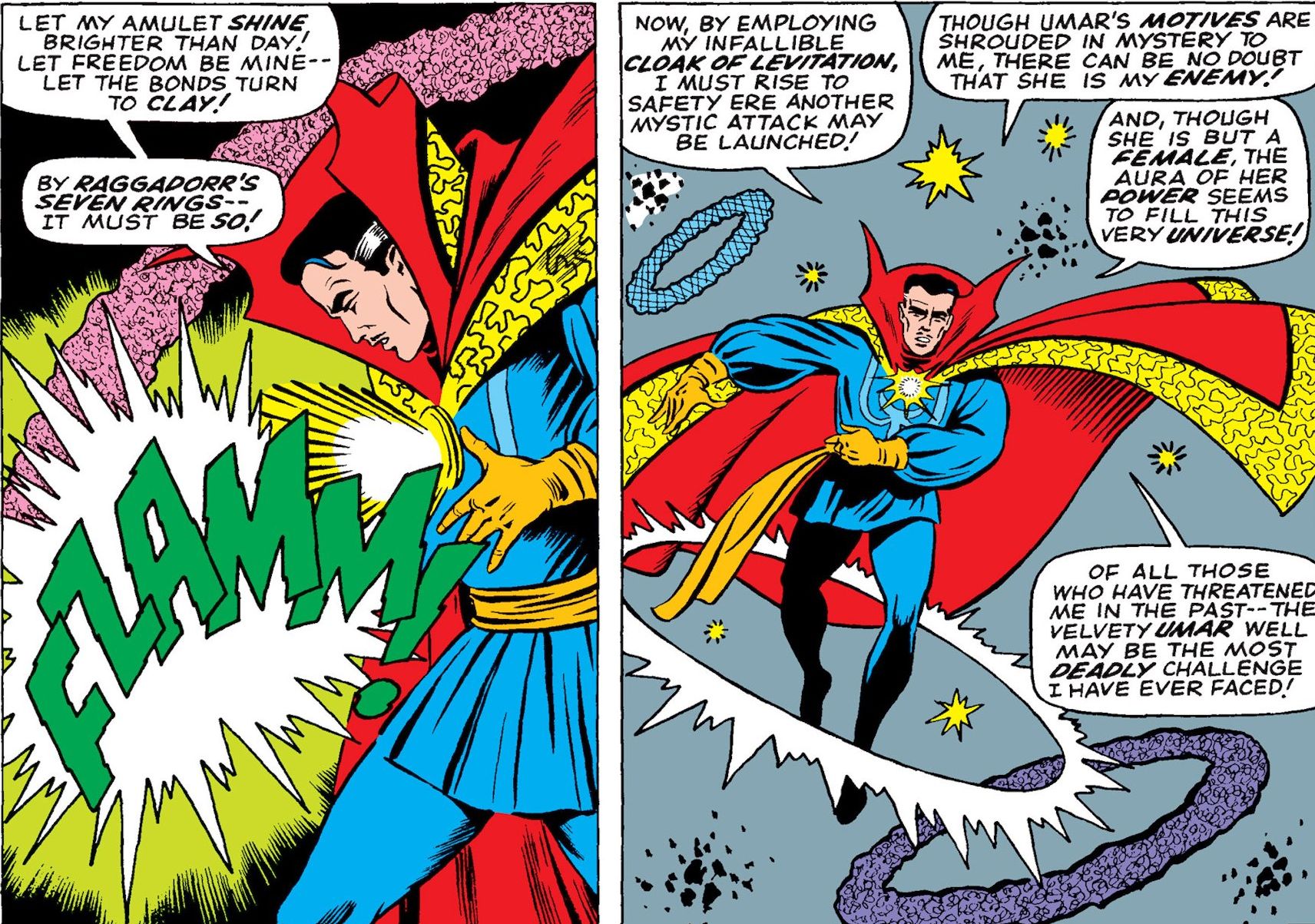
Credit : Marvel Comics.
Images from Strange Tales # 152, by Stan Lee and Bill Everett
What is funny is Marvel apparently was progressive for its time. And indeed, this sexist attitude gradually but surely sinks down as months pass by. Invisible Girl develops more interesting powers, we have more female superheroes, and women with depth, and unique personalities, their attitudes grow more confident, and their male counterparts begin to see them as equals. It is interesting to see how the developments in actual reality reflects on the comics too, as women's liberation movement also starts around the times these issues were written. But that is an entirely different article.
3) Daredevil sucked.
This is another discovery that really surprised me. I knew Daredevil became awesome only when Frank Miller took over the reins in 1979, but I was expecting you know, some quality in the earlier comics. I mean most of the other heroes had strong starts, why not him?
What is interesting is his origin issue nails down what makes Daredevil so great. The atmosphere and the tone are right, the personality is right, Daredevil is a true detective-like street hero that handles street crimes, and battles injustices that consistently find their way through the holes in the legal system.
But right after that awesome introduction, somehow Stan Lee manages to lose track of the character. He is basically a regular super-hero now, fighting super-powered baddies, aliens, robots, and there is almost none of the legal drama you would expect a comic featuring a lawyer character to include. What is worse is the stories are boring, and Matt Murdock himself is a real crazy a-hole. Dude just sucks.
He is a perpetual liar, he is annoying and over-confident, at one point when his identity is found out by their friends, he utters the most basic and unbelievable lie, and claims Daredevil is actually his naughty twin named Mike Murdock, and invents a completely new identity from that point on. The superhero equivelant of dog ate my homework I guess. He goes on to place this new version of himself in his friends' lives, toys with their feelings, at one point he even legitimately questions if he should propose to Karen Page as Matt Murdock or Mike Murdock. I mean, come on. Dude sees other people as NPCs and doesn't act like he cares about their feelings or sanity. One can't help but wonder how he became one of the sanest, and coolest characters in Marvel Comics.
Many writers take over the reins after Stan Lee, but they have as much a tough time nailing what Daredevil should be about as Lee did. Otherwise solid writers like Gerry Conway, Tony Isabella, and Steve Gerber all consistently fail to see the characters' true identity was right in front of their eyes all this time in issue # 1. All hail Frank Miller, the guy who saw the obvious. May he take his place as a Comic God in the afterlife.
4) Thor keeps battling communists, but wait it makes sense
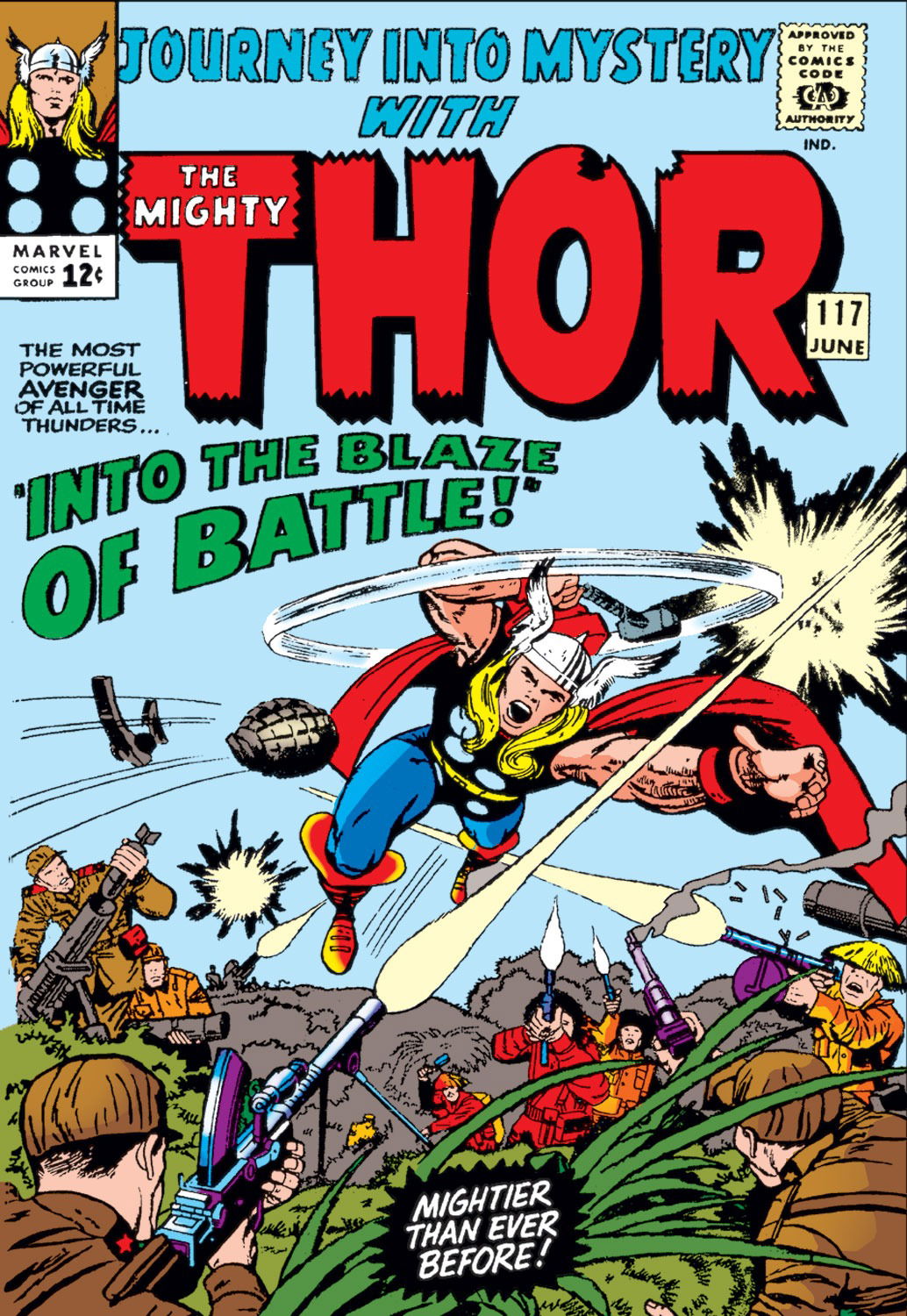
Okay this sounds dumb, and feels like obvious propoganda when you read it. And since the the first half of 1960s of Marvel is a bit heavy in propoganda, it is probably not an ungrounded reaction. However it actually makes sense when you think about the stories themselves.
I know, how can it make sense for an Asgardian God to choose side in the international politics, and fight on the USA's side as if they are the universal good guys? Well it turns out Thor's situation is different compared to his MCU portrayal, which is where I started to know about the character first.
In the comics, an American doctor with a lame leg named Don Blake actually stumbles upon Mjolnir which transforms him to Thor. And he keeps switching between characters, and gets confused about his own identity, as when he becomes Thor he feels more like an Asgardian with his own memories, personality, and social circle of gods and demigods, and when he becomes Blake he has his own persona, and his own life style. Due to his confusion he doesn't know who is the real one, or if they are the same person, so it is natural for Thor who is subjected to the Blake persona to fight at the side of "Allies".
We later (quite later) find out that Thor was the real character all along, and Blake was the invented one. In a pretty well written retconn, we learn that Thor was spoiled and lacked humility, so to make him learn it Odin (as if he is Mr. Perfect himself) blocked his memories, transformed him to Blake with his own fake childhood memories, and dumped him to America. He was to be subconsciously drawn towards Mjolnir if he matured enough. However due to living a lot of years as Blake, Thor still feels continues to be consufed, and split between his two identities.
So it kinda makes sense in the stories' context that Thor would choose to clash alongisde the western world.
5) The best Spider-Man stories are his first 100 issues
Remember when I said I have read whatever Spider-Man story I can get my hands on? Well surprisingly none of those included a comic from his first hundred issues (save his origin story), which are composed of Ditko-Lee, and Romita-Lee runs. So when I began reading the first Amazing Spider-Man stories I was expecting stories with lower quality, with the main excitement and points of interest being the first appearances of all the Spider-Man characters we know and love.
I was really surprised at finding the first hundred issues were even better than the later Spider-Man stories I have read. That doesn't mean the later stories are bad, far from it but the original run is so good it actually surpasses the future runs. It is in this run that Peter finds himself (also through the famous Spider-Man No More story, which of course inspired Sony's classic Spider-Man 2 movie) faces challenges, grows and becomes the Spider-Man we are familiar with, it is in this run where Green Goblin finds out his secret identity, Peter meets Gwen Stacy, and his father figure Captain Stacy dies. If This Be My Destiny story is also in this run, which is probably among the best arcs of Spider-Man, if not the best.
Stan Lee, who doesn't have consistently interesting writing in other titles (except for several streaks, especially Fantastic Four # 37 - 53) must have really paid special attention to this character. He has written Peter's dialogue exceptionally well, and he really made you feel that Peter is a real character as human as you are (which is what Spider-Man is all about), and the stories are also very interesting and intricate.
While the other titles' supporting casts are often boring, they shine in this run. Take a look at these names : Aunt May, J. Jonah Jameson, Flash Thompson, Mary Jane, Gwen Stacy, Captain Stacy, Betty Brant, Harry Osborn, Dr. Curt Connors..these are characters as famous as some superheroes. What is better is Stan wrote their relationships so good I can honestly read an entire issue of Peter just having a casual hang-out with his 'gang'.
Just an example of how realistic Stan writes the ASM stories is the issue of Amazing Spider-Man # 93. At one time Spider-Man has to throw off suspicions about his alter-ego, and show Peter Parker is not the masked vigilante. So he goes to one of the very few friends he has made within his costumed identity, and asks Prowler to show up in his Spidey suit and climb around while as Peter Parker he hangs out in some meeting.
Some issues later (in the mentioned # 93) Spider-Man becomes public enemy number 1 which isn't exactly shocking. Prowler actually gets paranoid that Spidey may have framed him of something when he made him show up in his Spidey suit in the meeting, because Spidey didn't even tell why he needs Prowler to walk around in his costume. This is really intricate and creative writing, most writers would forgot that this ever happened, but when you think about it it makes perfect sense that Prowler would be anxious about this.
Rest in peace Stan.
6) Hulk has a very shaky start
I had no idea how weird Hulk's beginnings were. Before he gets to be the jolly green giant we know him to be, his status-quo changed at an insane pace. It is obvious the creators were experimenting to make the character the most interesting version he can be. Which is of course natural for a brand new, off-beat superhero character.
In his origin issue, he is basically a grey golem-like being who operates in werewolf principles. He actually becomes the Hulk when the sun sets, instead of when he gets stressed or angry. He moves slowly, doesn't jump all around the place, and he is not particularly strong either. It seems that he had at best Spider-Man levels of strength.
In the second issue he resembles more of his future self, as his skin turns to green (which was funnily enough, due to inking problems). In the third issue he begins making his famous sky leaps. There is a weird, brief period where he takes telephatic commands from Rick Jones, when some very shaky scientific process causes the two to link their minds or something.
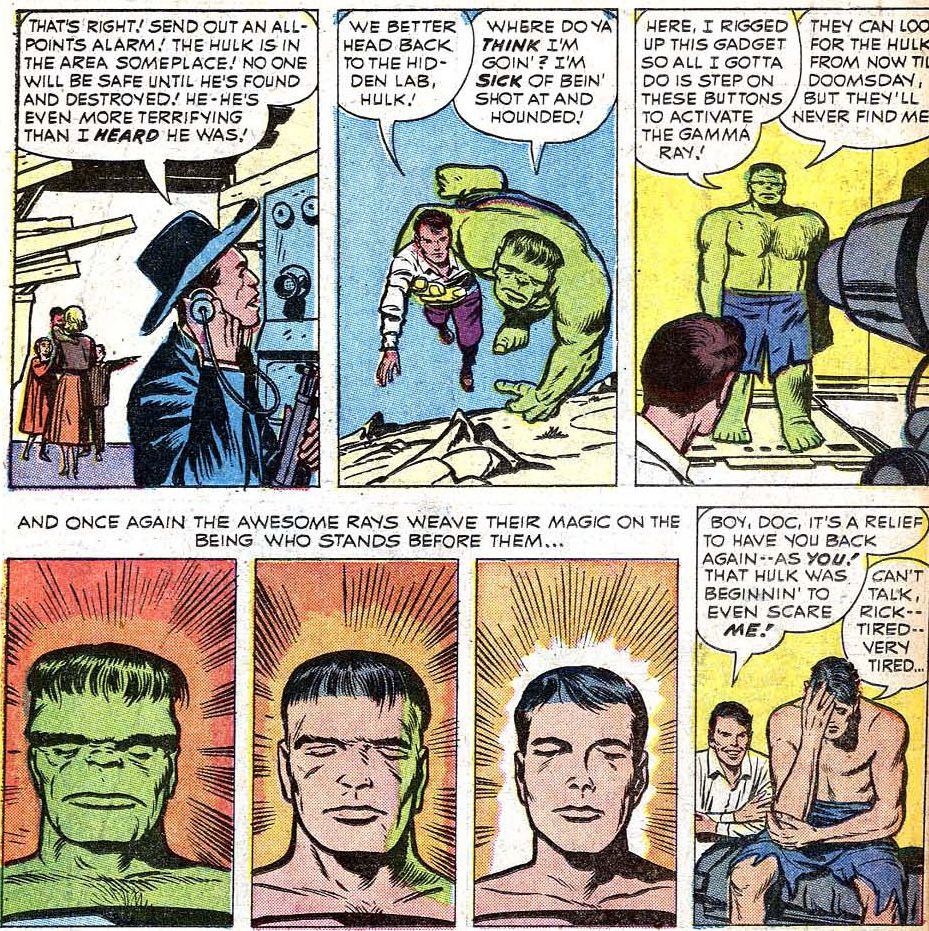
Credit : Marvel Comics.
Images from The Incredible Hulk # 4, by Stan Lee and Jack Kirby
Things change very fast. It is honestly surprising how his concept almost never stayed the same within two issues. Even how Banner becomes the Hulk keeps changing, at one time he voluntarily changes with a machine he invents. While his strength gets a buff a few months later, it still takes some years until he becomes an extreme powerhouse. This is seemingly caused by the Leader who gives him a heavy gamma dose after he heals him from a bullet lodged in his head, way forward in Tales to Astonish # 73, which has a release date of August 1965.
So it takes a galloping amount of three years for the Hulk to find his place. Unfortunately the stories themselves took much longer to be really interesting, although he had some good ones time to time.
7) Stan Lee was all over the place
I was especially interested in reading the issues written by the legendary man himself, Stan Lee. He is of course one of the few people who is responsible for the Marvel legacy, creating at least half of its beloved roster, including heroes, side characters, and villains. No one needs to be reminded of that. But what I was curios about was his writing style especially because opinions about him seem to be very divided. Well, what I found out was, he was all over the place which explains why the division persists.
He has written great stories, and he has written some bad ones. Even excellent writers of course has ideas that doesn't work, but Stan Lee's stories really jumped around in quality. His stories in Tales to Astonish, and Strange Tales were particulary bad, the former featuring the Ant-Man, and later the Wasp, and the latter featuring the Human Torch. Within the same month alone, I read some trash issues to speak plainly, and some wonderful ones. Whenever I was sold that his writing wasn't all that great, I would read some amazing story again where his writing would impress me.
There was a particularly good period where he consisently wrote extremely solid stories though. This is the legendary era when the Fantastic Four # 37 - 53 was released, which includes the origins of the Inhumans, Silver Surfer, Galactus, and the Black Panther, and the stories are awesome beyond the first appearances. In the same time period he also wrote some classic Spider-Man stories, which included the famous If This Be My Destiny arc. He must really have been inspired for a year or two.
The reason for this inconsistency was probably his busy schedule. I am actually very impressed how this short-staffed Marvel team had managed to keep up with all the deadlines back in the day. By 1965, Marvel was releasing eight titles monthly, and while the art itself is divided between several artists, Stan Lee wrote almost all of these issues by himself. Even though artists were often responsible for most of the plotting, that is still a crazy amount of work, especially considering a Silver Age issue included a ridiculous amount of events and dialogues, so no wonder there were times he messed up.
I have to mention how he applied science to his stories is unforgivable though. I mean this is comics where few things make sense if you think realistically, but they still have to be somewhat grounded in reality. Just one example he regularly featured omnipotent magnets in his stories, which attracted non-ferrous metals. I had quite a few times when I rolled my eyes. And his obsession with hypnotism. Don't even make me started on that.
8) Iron Man is extremely mediocre
I knew Iron Man was always a B level hero in the Marvel Comics, and the character really got his fame with his already legendary MCU appearance, played by the talented actor Robert Downey, Jr. I was still expecting some better stories with this character however. After the solid origin issue where he becomes Iron Man when his heart gets injured in Vietnam, his adventures get plainly boring.
His high society life style isn't written well, his relationships are very rarely interesting, and the stories don't have much logic. They are also repetitive, with some kind of sabotage periodically occurring in his plants, which also cause the Pentagon and the United States government get suspicious of him in the paranoid Cold War era. These plot points so to speak actually have the potential to become something really interesting, but Stan Lee failed massively in that.
These shortcomings would still be forgiven had his power levels not been all over the place, which made stories illogical and inconsistent. He can carry a huge rocket on his shoulders in one issue, then struggle against some lame villain that Thing's Aunt Petunia should have no trouble beating. I stared at disbelief how he consistently struggled against the Melter for example, the guy has only a small gun that melts metals, and he doesn't seem to have any kind of armor on. He is basically running around in his pyjamas. And Iron Man is scared of this villain as much as Spidey fears Venom. Just fly around him and punch him to sleep dude, come on. In the worst case scenario he should only be able to melt a few parts of your armor which you can easily replace in an hour.
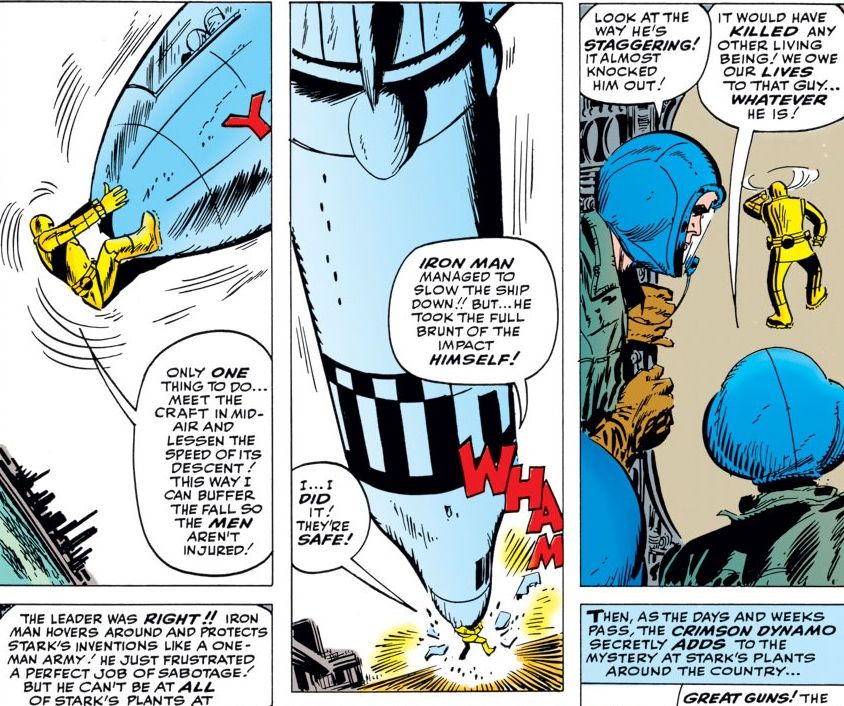
Credit : Marvel Comics.
Images from Tales of Suspense # 46, by Stan Lee, R. Berns, and Don Heck
As a result the action also wasn't good. So these early Iron Man stories really get tiring, and makes you want to just stream an Iron Man movie so you get reminded how awesome the character can really be.
9) It's not the character, it is the writing
This is another realization that should be obvious, and of course which I already knew before. But I didn't realize the extents of this fact. It is true that some characters will always be more popular, or more interesting than others. Maybe there is something about the costume, the setting, or maybe even because the character's look makes people relate to them more.
However the more I read, the more I realized there is really not an uninteresting character. You can make even the most boring hero or villain shine with an intricately written story, in a fitting setting that makes them work in it. The evidence for this is everywhere really. You can pick an issue of even your favorite superhero, and get bored or annoyed reading it, because the writer (or sometimes the artist) fails to grasp what the character is about. Another proof of this is in the MCU itself. As we mentioned, Iron Man was a B-level hero at best who ended up as the main star when the character was written right (not ignoring the actor's part for the success). And what about the Guardians of the Galaxy? No one could predict how successful and fun they could be when they were announced, and nearly everyone thought MCU was taking a huge risk with these highly unknown, niche characters. They ended up winning the heart of almost everyone, because they made the characters work with the stories, and the setting.
Before my adventure with Marvel history, there were a lot of superheroes I now see I was prejudiced against. Even more if I go back to times where I wasn't influenced by their MCU portrayals. I thought Thor and Hulk were terribly uninteresting, because they were extremely strong, so I wouldn't be sold into their stories, or these stories wouldn't have high-stakes. I thought Captain America was just a propoganda character who kept praising USA. In some of the cases these were true, but only when they weren't written in the correct way. Thor's stories especially dipped in Asgardian mythology ended up very interesting, and Hulk turned out to be such a fun character if done right. I already mentioned how surprised I was with some Captain America portrayals.
And what about the opposite side of the spectrum? As a fan of X-Men, I was really disappointed in their original run. They had a good enough start. Although far from having the X-Men style we know, the first sixteen or a few more issues written by Stan Lee weren't bad at all. However they soon became almost the worst Marvel at the time offered when different writers took over the reins. So much so that the series were actually cancelled by the end of 1969, which was funnily enough right when they showed the signs of the classic X-Men that fans adore, with the Roy Thomas - Neal Adams run. The reason for this was apparently the fact that Marvel staff could only learn how their comics were faring a year after their release, so they assumed the new run would also fare badly, but that is perhaps the topic of another article.
So all these examples prove that every character can be very interesting, and entertaining if you make their stories right. And you should give everything a chance.
10 ) Magneto was just a psychopathic villain
I have heard that Magneto wasn't always a deep villain, and it was Chris Claremont who really made him a terrific character, many years later when he took over the reins. But I was still expecting that Stan Lee has sown some seeds of potential in the character, and Claremont has only advanced the character in a natural evolution. What I have found is, Claremont basically retconned the character, and it actually doesn't remotely make sense Magneto turned out the way he is later in the comics (hence the word retconn).
He had no redeemable qualities whatsoever. You could never say Magneto was right, let me put it that way. He was just your run-of-the-mill, stereotypical one dimensional comical villain that is obsessed with ruling the world. Even his facial expressions were shown as over the top villainous, the insane, chaotic evil kind. He also wasn't particularly interested in the mutant agenda, or his people's well-being either. He wanted to take over the world just because, and he could intimidate others with his powers, so he formed his Brotherhood of Evil Mutants, and used them as lackeys. If he really is a good person or not is always going to be discussed of course, but he is never portrayed one-dimensionally evil after his retconn.
He had little philosophy or depth behind his actions, nor were there any meaningful contrast between his world view, and Charles Xavier's. The two weren't even showed as old friends, basically Magneto was just a villain for story's sake, a powerhouse that causes trouble for the X-Men. All these talks about Magneto and Xavier being inspired by Malcolm X and Martin Luther King seem to be untrue, or if Lee based them on these two political figures, he either did it subconsciously, or he didn't do it in a meaningful way. In fact for about two years, the world wasn't shown as hating or fearing the mutants (except in a few panels so there were some seeds there), so Magneto didn't even seem to have a reason for a political cause.
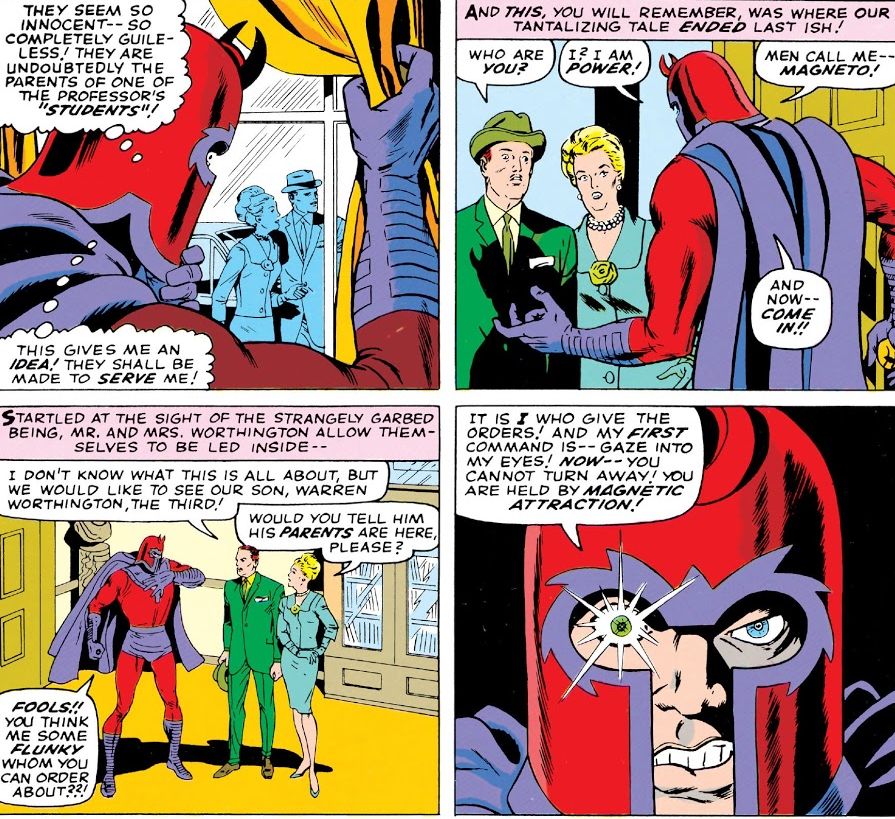
Credit : Marvel Comics.
Images from Uncanny X-Men # 18, by Stan Lee, Jay Gavin, and Dick Ayers
I guess this shouldn't be that surprising when you think about it. Comic book villains in general weren't shown to be particularly deep or more than one-sided in older comics, at least if you only take Marvel Comics into consideration. So Magneto's case isn't really a unique one, but the contrast between his original portrayal and his later appearances are so different it sticks out like a sore thumb.
12) Secret identities are extremely messy
This one really surprised me. The secret identities of the superheroes were so sloppy that you can't help but wonder if Stan Lee was really keeping track of them, or was just experimenting along thinking people would not care about it. The most glaring of these errors occurs with the Human Torch's case. In the Fantastic Four comics, the whole world knows who Johnny Storm is. His fans run up to him in his civil life, and he even attends an award ceremony in the White House where Fantastic Four is praised which should be televised all around the world.
Yet when he gets his own solo series with the Strange Tales magazine, his identity is not known. These stories are definitely canon. It is unclear (to me at least) if Lee has just forgotten about it, or he thought a solo superhero series needs its own secret identity drama. Regardless of the reasons, Marvel universe's consistency, and the world building suffers immensely. Thankfully in later stories, people come up to him, and say they actually always knew who he was, but apparently all of the Marvel citizens were extremely emphatic people, because they didn't want to bother him, and played along with his secret. The explanation doesn't make one lick of sense, but at least it is resolved.
Captain America's secret identity is also very messy. Before he is reintroduced to the modern Marvel timeline in the legenday Avengers # 4 issue, it seems to be publicly known that Steve Rogers was Captain America. Johnny Storm is shown to read an old Captain America comic, and mentions how he loved the real stories of Private Steve Rogers in action, and how he is a fan of the legend.
Yet after the Avengers, in frankly an unbelievable coincidence (the Silver Age comics are particularly over the top in coincidences) find him drifting in the ice, the world seems to have developed an amnesia. No one knows who Steve Rogers is. While this could be forgiven because the proof that they should, is only shown in a few panels in previous magazines, things get even more messy.
Captain America decides to do a face reveal, and declare his secret identity to the world. But later he begins to find out how terrible a decision that was, and there is a good reason why many superheroes keep it secret. The good old their loved ones being targeted by their enemies of course. He also wants his private life, and wants to find out who Steve Rogers is under his American symbol identity.
In a rather sloppily written story, he fakes his death by falling into the shores of New York City, and a Steve Rogers mask is found drifting ashore. Apparently this is seen as an undeniable proof that Steve Rogers was also an invented identity (the one who fell in water may not be the real Captain America for instance). But what is extremely weird is, the world develops yet another amnesia. After Captain America returns to the superhero scene, no one knows who Steve Rogers is. The world famous hero who is the public symbol of a nation, hence a celebrity walks around in his private life, doesn't change his name, he even takes a job as a police officer, and no one seems to remember Rogers was Captain America, or has any memory about the incident in the docks.
This is so obvious an error which has to be explained in future issues in most likely a retconn by Roy Thomas. It turns out the Avengers villain Space Phantom needed to use Captain America in his evil plottings, and Cap had to be calm in the surgical procedure he was going to perform on him. He realized Captain America had significant anxiety due to his known identity, so with some dubious technology he made everyone forget who the red, white and blue superhero was. And yes this apparently involved all his paper records, newspaper articles, and documentaries. But that is comics, I guess.
13) Time flows ridiculously fast
In the older comics, the years the stories take place were not hidden, or writers did not shy away from declaring exactly how long ago a particular event was. This is of course a natural result of wanting to not let these characters retire, so they are stuck in a time loop or something, and age extremely slowly. In fact it is due to this reason that Marvel invented their sliding time scale, in which earlier stories change to make them fit with the modern times. Such as Tony Stark not being injured in Vietnam, but in Afghanistan. It is arguable if this works or not, but it is a necessary evil I guess.
But the original approach wasn't a good one either. Basically in the earlier comics (in fact for a good number of years), time flow mirrored reality. So characters aged a month in every issue. This of course also doesn't work, because sometimes events happen in let's say three issues which obviously take place in a period of days, yet the third issue mentions how three months has passed since the story started. Even the seasons change insanely fast. One character takes a trip to some country in January, has a week of adventure in three issues, and comes back to New York in spring time.
As a result time is as illogical as it is in the sliding time scale. In only thirty issues Peter Parker begins and graduates from his high school. The change isn't fluid either. In one instance, Peter mentions how his love Gwen Stacy died in a few months ago, while in real time more than a year has passed. And you say finally, this stuff is over. Yet just a few issues later, he suddenly declares he can't believe how two years have passed since her death, and he is finally getting over it.
Yeah, time is a mess no matter which approach you take. You are either going to have to retire these characters, or have them age faster, or you are going to have to keep the stories and their times consistent. Maybe a middle ground is possible, such as making the time flow slower without sliding scale shenanigans, but this would still make the stories and the setting unfamiliar by the modern readers. If they took this approach there would be no Internet for example in the Marvel world, which is not good.